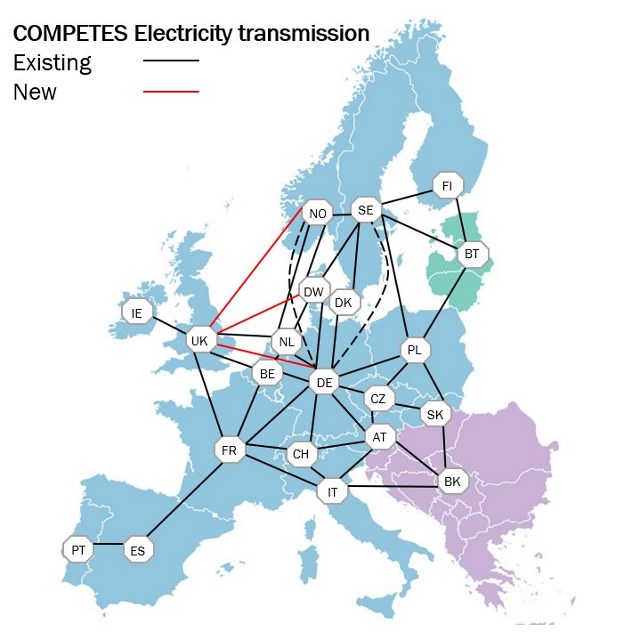COMPETES-TNO
COMPETES-TNO is a power system optimization and economic dispatch model that seeks to meet European power demand at minimum social costs (maximizing social welfare) within a set of techno-economic constraints - including policy targets/restrictions - of power generation units and transmission interconnections across European countries and regions [1] . The model is implemented in the Advanced Interactive Multidimensional Modelling System (AIMMS).
COMPETES-TNO consists of two major modules that can be used to perform hourly simulations for two types of purposes:
- A transmission and generation capacity expansion module to determine and analyse least-cost capacity expansion under perfect competition formulated as a linear program to optimize generation capacity additions in the system
- A unit commitment and economic dispatch module to determine and analyse least-cost unit commitment (UC) and economic dispatch under perfect competition, formulated as a mixed-integer program considering flexibility and minimum load constraints and start-up costs of generation technologies
The COMPETES-TNO model covers all EU Member States and some non-EU countries - i.e., Norway, Switzerland, the UK and the Balkan countries (grouped into a single Balkan region) - including a representation of the cross-border power transmission capacities interconnecting these European countries and regions (see Figure 1). The model runs on an hourly basis, i.e., it optimizes the European power system over all 8760 hours per annum.

For each scenario year, the inputs of COMPETES-TNO include the following:
- Electricity demand across all European countries/regions, including conventional power demand and additional demand due to further sectoral electrification of the energy system utilizing P2X technologies
- Power generation technologies, transmission interconnections and flexibility options, including their techno-economic characteristics
- Hourly profiles of various electricity demand categories and RES technologies (notably solar, wind and hydro), including the full load hours of these technologies
- Assumed (policy-driven) installed capacities of RES power generation technologies
- Expected future fuel and CO2 prices
- Policy targets/restrictions, such as meeting specific RE/Greenhouse gas (GHG) targets or forbidding the use of certain technologies (for instance, coal, nuclear or CCS)
As indicated above, COMPETES-TNO includes a variety of flexibility options:
- Flexible power generation
- Conventional: gas, coal, nuclear
- Renewable: curtailment of solar/wind
- Cross-border power trade
- Cross-border hydrogen trade
- Storage
- Pumped hydro (EU level)
- Compressed air (CAES/AA-CAES)
- Batteries (EVs, Li-ion, PB, VRB)
- Underground storage of hydrogen
- Demand response
- Power-to-mobility (P2M): EVs, including grid-to-vehicle (G2V) and vehicle-to-grid (V2G)
- Power-to-heat (P2H): industrial (hybrid) boilers and household (all-electric) heat pumps
- Power-to-gas (P2G), notably power-to-hydrogen (P2H2)
On the other hand, for each scenario year and each European country/region, the main outputs ('results') of COMPETES-TNO include:
- Investments and disinvestments ('decommissioning') in conventional and vRES power generation
- Investments in interconnection capacities, both for electricity and hydrogen
- Investments in storage
- Hourly allocation ('dispatch') of installed power generation and interconnection capacities, resulting in the hourly and annual power generation mix - including related CO2 emissions and power trade flows - for each European country/region
- Demand and supply of flexibility options
- Hourly electricity prices
- Hydrogen prices
- Annual power system costs for each European country/region
[1] Over the past two decades, COMPETES-TNO was originally developed by ECN Policy Studies - with the support of Prof. B. Hobbs of the Johns Hopkins University in Baltimore (USA) - but since 2018 it is used/developed TNO Energy Transition Studies.